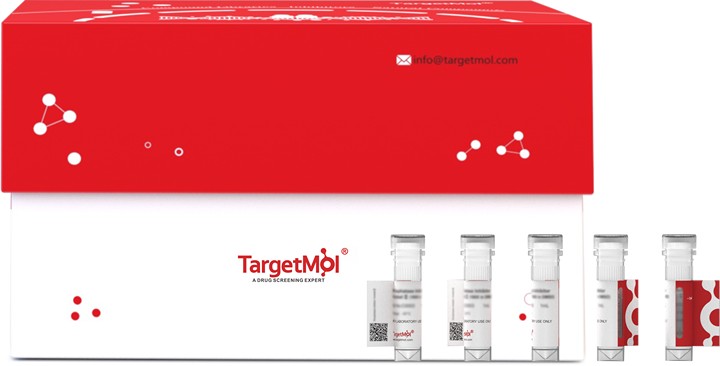Shopping Cart
Remove All Your shopping cart is currently empty
Your shopping cart is currently empty
TNF superfamily member 15 (TNFSF15), a cytokine largely produced by vascular endothelial cells and a specific inhibitor of the proliferation of these same cells, can inhibit VEGF-induced vascular permeability in vitro and in vivo, and that death receptor 3 (DR3), a cell surface receptor of TNFSF15, mediates TNFSF15-induced dephosphorylation of VEGFR2. TNFSF15 Trimer Protein, Human, Recombinant (His & Flag) is expressed in HEK293 mammalian cells with N-His-Flag tag. The predicted molecular weight is 58.2 kDa and the accession number is O95150-1.

| Pack Size | Price | USA Warehouse | Global Warehouse | Quantity |
|---|---|---|---|---|
| 5 μg | $56 | 7-10 days | 7-10 days | |
| 10 μg | $88 | 7-10 days | 7-10 days | |
| 20 μg | $143 | 7-10 days | 7-10 days | |
| 50 μg | $278 | 7-10 days | 7-10 days | |
| 100 μg | $465 | In Stock | In Stock | |
| 200 μg | $839 | 7-10 days | 7-10 days | |
| 500 μg | $1,850 | 7-10 days | 7-10 days |
| Biological Activity | 1. Immobilized Human TNFSF15 Trimer, His Tag at 0.5μg/ml (100μl/Well) on the plate. Dose response curve for Anti-TNFSF15 Antibody, hFc Tag with the EC50 of 10.2ng/ml determined by ELISA.
2. Mouse DR3, His Tag immobilized on CM5 Chip can bind Human TNFSF15 (Trimer) , His Tag with an affinity constant of 3.06 nM as determined in SPR assay. |
| Description | TNF superfamily member 15 (TNFSF15), a cytokine largely produced by vascular endothelial cells and a specific inhibitor of the proliferation of these same cells, can inhibit VEGF-induced vascular permeability in vitro and in vivo, and that death receptor 3 (DR3), a cell surface receptor of TNFSF15, mediates TNFSF15-induced dephosphorylation of VEGFR2. TNFSF15 Trimer Protein, Human, Recombinant (His & Flag) is expressed in HEK293 mammalian cells with N-His-Flag tag. The predicted molecular weight is 58.2 kDa and the accession number is O95150-1. |
| Species | Human |
| Expression System | HEK293 Cells |
| Tag | N-His-Flag |
| Accession Number | O95150-1 |
| Synonyms | VEGI-251,VEGI192A,VEGI,TNFSF15,TL1A,TL1 |
| Construction | Asp91-Leu251 |
| Protein Purity | > 95% as determined by Tris-Bis PAGE; > 95% as determined by HPLC |
| Molecular Weight | 58.2 kDa (predicted). Due to glycosylation, the protein migrates to 65-75 kDa based on Tris-Bis PAGE result. |
| Endotoxin | < 1 EU/μg by the LAL method. |
| Formulation | Lyophilized from a solution filtered through a 0.22 μm filter, containing PBS (pH 7.4). Typically, 8% trehalose is incorporated as a protective agent before lyophilization. |
| Reconstitution | Reconstitute the lyophilized protein in distilled water. The product concentration should not be less than 100 μg/ml. Before opening, centrifuge the tube to collect powder at the bottom. After adding the reconstitution buffer, avoid vortexing or pipetting for mixing. |
| Stability & Storage | It is recommended to store recombinant proteins at -20°C to -80°C for future use. Lyophilized powders can be stably stored for over 12 months, while liquid products can be stored for 6-12 months at -80°C. For reconstituted protein solutions, the solution can be stored at -20°C to -80°C for at least 3 months. Please avoid multiple freeze-thaw cycles and store products in aliquots. |
| Shipping | In general, Lyophilized powders are shipping with blue ice. |
| Research Background | TNF superfamily member 15 (TNFSF15), a cytokine largely produced by vascular endothelial cells and a specific inhibitor of the proliferation of these same cells, can inhibit VEGF-induced vascular permeability in vitro and in vivo, and that death receptor 3 (DR3), a cell surface receptor of TNFSF15, mediates TNFSF15-induced dephosphorylation of VEGFR2. |
| Size | Quantity | Unit Price | Amount | Operation |
|---|

Copyright © 2015-2025 TargetMol Chemicals Inc. All Rights Reserved.